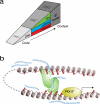The context of gene expression regulation
- PMID: 22500194
- PMCID: PMC3318259
- DOI: 10.3410/B4-8
The context of gene expression regulation
Abstract
Recent advances in sequencing technologies have uncovered a world of RNAs that do not code for proteins, known as non-protein coding RNAs, that play important roles in gene regulation. Along with histone modifications and transcription factors, non-coding RNA is part of a layer of transcriptional control on top of the DNA code. This layer of components and their interactions specifically enables (or disables) the modulation of three-dimensional folding of chromatin to create a context for transcriptional regulation that underlies cell-specific transcription. In this perspective, we propose a structural and functional hierarchy, in which the DNA code, proteins and non-coding RNAs act as context creators to fold chromosomes and regulate genes.
Figures

Similar articles
-
Emerging roles of non-coding RNAs in epigenetic regulation.Sci China Life Sci. 2016 Mar;59(3):227-35. doi: 10.1007/s11427-016-5010-0. Epub 2016 Jan 29. Sci China Life Sci. 2016. PMID: 26825947 Review.
-
Non-coding RNAs as regulators in epigenetics (Review).Oncol Rep. 2017 Jan;37(1):3-9. doi: 10.3892/or.2016.5236. Epub 2016 Nov 8. Oncol Rep. 2017. PMID: 27841002 Review.
-
Single cell analysis pushes the boundaries of TAD formation and function.Curr Opin Genet Dev. 2020 Apr;61:25-31. doi: 10.1016/j.gde.2020.03.005. Epub 2020 Apr 14. Curr Opin Genet Dev. 2020. PMID: 32302920 Free PMC article. Review.
-
Chromatin Signature and Transcription Factor Binding Provide a Predictive Basis for Understanding Plant Gene Expression.Plant Cell Physiol. 2019 Jul 1;60(7):1471-1486. doi: 10.1093/pcp/pcz051. Plant Cell Physiol. 2019. PMID: 31038680
-
Control of Gene Expression in Senescence through Transcriptional Read-Through of Convergent Protein-Coding Genes.Cell Rep. 2017 Nov 28;21(9):2433-2446. doi: 10.1016/j.celrep.2017.11.006. Cell Rep. 2017. PMID: 29186682
Cited by
-
Chromatin associations in Arabidopsis interphase nuclei.Front Genet. 2014 Nov 13;5:389. doi: 10.3389/fgene.2014.00389. eCollection 2014. Front Genet. 2014. PMID: 25431580 Free PMC article.
-
Sperm Transcriptome Analysis Accurately Reveals Male Fertility Potential in Livestock.Animals (Basel). 2022 Oct 27;12(21):2955. doi: 10.3390/ani12212955. Animals (Basel). 2022. PMID: 36359078 Free PMC article. Review.
-
Dissecting the chromatin interactome of microRNA genes.Nucleic Acids Res. 2014 Mar;42(5):3028-43. doi: 10.1093/nar/gkt1294. Epub 2013 Dec 18. Nucleic Acids Res. 2014. PMID: 24357409 Free PMC article.
-
Reverse Engineering of Genome-wide Gene Regulatory Networks from Gene Expression Data.Curr Genomics. 2015 Feb;16(1):3-22. doi: 10.2174/1389202915666141110210634. Curr Genomics. 2015. PMID: 25937810 Free PMC article.
-
Dynamics of chromatin accessibility and long-range interactions in response to glucocorticoid pulsing.Genome Res. 2015 Jun;25(6):845-57. doi: 10.1101/gr.184168.114. Epub 2015 Feb 12. Genome Res. 2015. PMID: 25677181 Free PMC article.
References
Grants and funding
LinkOut - more resources
Full Text Sources

